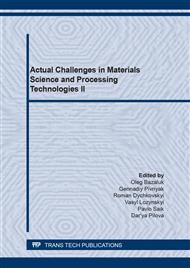[1]
Seneor, P., Bernand-Mantel, A., & Petroff, F. (2007). Nanospintronics: when spintronics meets single electron physics. Journal of Physics: Condensed Matter, 19(16), 165222. https://doi.org/10.1088/0953-8984/19/16/165222.
DOI: 10.1088/0953-8984/19/16/165222
Google Scholar
[2]
Kervalishvili, P., & Lagutin, A. (2008). Nanostructures, magnetic semiconductors and spintronics. Microelectronics Journal, 39(8), 1060-1065. https://doi.org/10.1016/j.mejo.2007.08.001.
DOI: 10.1016/j.mejo.2007.08.001
Google Scholar
[3]
Chopra K.N. (2013). New Materials and their Selection for Designing and Fabricating the Spintronic Devices - A Technical Note. Italian Journal of Optoelectronics - Atti Fond G. Ronchi, 68, 673-680.
Google Scholar
[4]
Chopra, K.N. (2013). A short note on the organic semiconductors and their technical applications in spintronics. Lat Am J Phys E, 7(4), 674-679.
Google Scholar
[5]
Chopra, K.N. (2014). A technical note on magnetic tunneling junctions, their types, structures and significance in spintronics. Invertis Journal of Science & Technology, 7(4), 246-254.
Google Scholar
[6]
Chopra, K.N. (2013). A short note on the mathematical modeling of spintronic devices. Italian Journal of Optoelectronics – Atti Fond G. Ronchi, 68, 39-54.
Google Scholar
[7]
Fang, D., Kurebayashi, H., Wunderlich, J., Výborný, K., Zârbo, L.P., Campion, R.P., & Ferguson, A.J. (2011). Spin-orbit-driven ferromagnetic resonance. Nature Nanotechnology, 6(7), 413-417. https://doi.org/10.1038/nnano.2011.68.
DOI: 10.1038/nnano.2011.68
Google Scholar
[8]
Goldhaber-Gordon, D., Göres, J., Kastner, M. A., Shtrikman, H., Mahalu, D., & Meirav, U. (1998). From the Kondo Regime to the Mixed-Valence Regime in a Single-Electron Transistor. Physical Review Letters, 81(23), 5225-5228. https://doi.org/10.1103/physrevlett.81.5225.
DOI: 10.1103/physrevlett.81.5225
Google Scholar
[9]
Žutić, I., Fabian, J., & Das Sarma, S. (2004). Spintronics: Fundamentals and applications. Reviews of Modern Physics, 76(2), 323-410. https://doi.org/10.1103/revmodphys.76.323.
DOI: 10.1103/revmodphys.76.323
Google Scholar
[10]
Dash, S.P., Sharma, S., Patel, R.S., de Jong, M.P., & Jansen, R. (2009). Electrical creation of spin polarization in silicon at room temperature. Nature, 462(7272), 491-494. https://doi.org/10.1038/nature08570.
DOI: 10.1038/nature08570
Google Scholar
[11]
Wang, K., Ovchinnikov, I., Xiu, F., Khitun, A., & Bao, M. (2011). From Nanoelectronics to Nano-Spintronics. Journal of Nanoscience and Nanotechnology, 11(1), 306-313. https://doi.org/10.1166/jnn.2011.3155.
DOI: 10.1166/jnn.2011.3155
Google Scholar
[12]
Borschel, C., Messing, M.E., Borgström, M.T., Paschoal, W., Wallentin, J., Kumar, S., & Ronning, C. (2011). A New Route toward Semiconductor Nanospintronics: Highly Mn-Doped GaAs Nanowires Realized by Ion-Implantation under Dynamic Annealing Conditions. Nano Letters, 11(9), 3935-3940. https://doi.org/10.1021/nl2021653.
DOI: 10.1021/nl2021653
Google Scholar
[13]
Pramanik, S., Kanchibotla, B., Garre, K., Cahay, M., & Bandyopadhyay, S. (2007). Organic nano-spintronics. 2007 7th IEEE Conference on Nanotechnology (IEEE NANO). https://doi.org/10.1109/NANO.2007.4601173.
DOI: 10.1109/nano.2007.4601173
Google Scholar
[14]
Cottet, A., Kontos, T., Sahoo, S., Man, H. T., Choi, M.-S., Belzig, W., & Schönenberger, C. (2006). Nanospintronics with carbon nanotubes. Semiconductor Science and Technology, 21(11), S78-S95. https://doi.org/10.1088/0268-1242/21/11/S11.
DOI: 10.1088/0268-1242/21/11/s11
Google Scholar
[15]
Kontos, T., & Cottet, A. (2007). Towards nanospintronics. Europhysics News, 38(2), 28-30. https://doi.org/10.1051/EPN:2007008.
DOI: 10.1051/epn:2007008
Google Scholar
[16]
Nossa Márquez, J. F. (2013). Nanospintronics with Molecular Magnets-Tunneling and Spin-Electric Coupling. Lund University.
Google Scholar
[17]
Wickles, C., & Belzig, W. (2009). Electronic transport in ferromagnetic conductors with inhomogeneous magnetic order parameter and domain-wall resistance. Physical Review B, 80(10), 104435.
DOI: 10.1103/physrevb.80.104435
Google Scholar
[18]
Lai, N.S., Lim, W.H., Yang, C.H., Zwanenburg, F.A., Coish, W.A., Qassemi, F., & Dzurak, A.S. (2011). Pauli Spin Blockade in a Highly Tunable Silicon Double Quantum Dot. Scientific Reports, 1(1). https://doi.org/10.1038/srep00110.
DOI: 10.1038/srep00110
Google Scholar
[19]
(19) Wu Yihong, Nano Spintronics for Data Storage, in Encyclopedia of Nanoscience and Nanotechnology, Ed. Nalwa H. S. 10 (2003) 1-50.
Google Scholar
[20]
Koo, H.C., Kwon, J.H., Eom, J., Chang, J., Han, S.H., & Johnson, M. (2009). Control of Spin Precession in a Spin-Injected Field Effect Transistor. Science, 325(5947), 1515-1518. https://doi.org/10.1126/science.1173667.
DOI: 10.1126/science.1173667
Google Scholar
[21]
Lee, K.J., Stiles, M.D., Lee, H.W., Moon, J.H., Kim, K.W., & Lee, S.W. (2013). Self-consistent calculation of spin transport and magnetization dynamics. Physics Reports, 531(2), 89-113. https://doi.org/10.1016/j.physrep.2013.05.006.
DOI: 10.1016/j.physrep.2013.05.006
Google Scholar
[22]
Yang, Y., & Hu, B. (2014). Bio-based chemicals from biorefining: lipid and wax conversion and utilization. Advances in Biorefineries, 693-720. https://doi.org/10.1533/9780857097385.2.693.
DOI: 10.1533/9780857097385.2.693
Google Scholar


